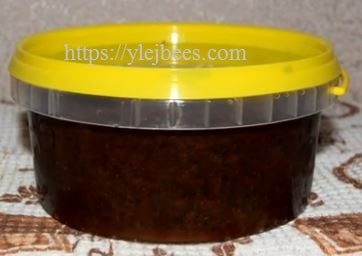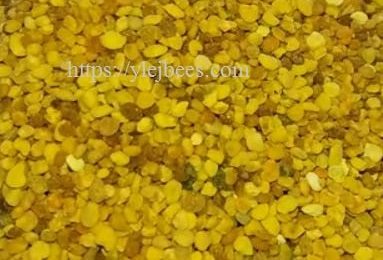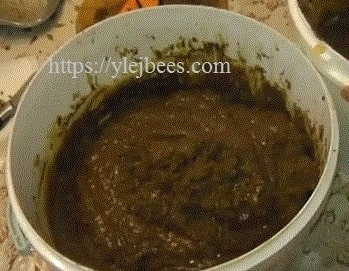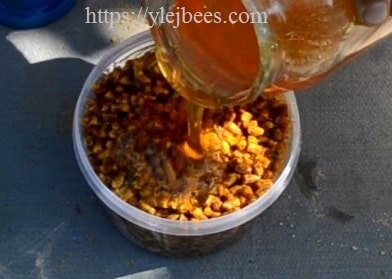Honey with bee bread or honey with pollen

Honey with pollen and honey with bee bread are one of the most popular forms in which people consume pollen and bee bread. Honey with pollen and honey with bee bread have many beneficial properties. Despite the fact that they have a lot in common, there are also differences in the preparation and benefits of the compositions, and there are also differences in some other points. So, honey with pollen and honey with beebread.
Content
- Honey with pollen, properties, preparation, proportions, how to take
- Honey with pollen proportions
- Pollen with honey how to take
- Honey with pollen beneficial properties
- Recipe for honey with pollen or how to prepare pollen with honey
- Honey with pollen contraindications
- Honey with beebread, properties, preparation, proportions, how to take
- Honey with bee bread beneficial properties
- How to take honey with beebread
- How to prepare bee bread with honey or bee bread with honey recipe
- Honey with beebread proportions
- Honey with beebread photo
- Bee bread with honey contraindications
- How to store beebread with honey
- How to choose honey with pollen and honey with beebread on the market
- Video treatment of diseases in France with honey and pollen
Honey with pollen, properties, preparation, proportions, how to take
Honey with pollen, what it is and how and why honey with pollen is prepared, what are the benefits and what are the contraindications. What are the most popular recipes for honey with pollen?
Honey with pollen is one of the most reliable ways to preserve pollen for a long time. Pollen collected by bees is unstable during storage and can quickly deteriorate. Properly dried pollen can be stored for a maximum of a year until it loses its beneficial qualities. Honey-soaked pollen can be stored for up to three years.
Bee pollen and honey complement each other to create a delicious medicine. A mixture of honey and pollen is absorbed by the body much better than flower pollen, which is taken in dry form. The fact is that in dry pollen the pollen grains are covered with a shell that does not dissolve in the stomach.
Honey with pollen is good to give to children, since pollen soaked in honey has a more pleasant taste and children will like it more.

Honey with pollen proportions
As a rule, honey is prepared with pollen in a 1:1 ratio by volume. It is also possible to prepare a less concentrated mixture of honey and pollen in a ratio of 1:1.5; 1:2, where there is more honey than pollen. A change in the concentration of pollen in honey affects only the single dose of the mixture taken - it increases accordingly.
Pollen with honey how to take
There are many tips on how to take pollen with honey for a person and in what doses. Different apitherapists advise differently and the daily dose ranges from 7.5 to 32 grams of pollen. The only question is how to take pollen with honey correctly. You can read more about this in the article “How to take pollen pollen.”
Pollen with honey properties
Oddly enough, there are quite a large number of skeptics who doubt the benefits of flower pollen in principle, and the benefits of pollen with honey in particular. They completely ignore not only the fact that a few decades ago in pharmacies it was possible to purchase medicinal paste “Energy” (which was nothing more than a concentrate of pollen with honey). In pharmacies there were many other medications based on pollen with honey and the addition of royal jelly, propolis and other bee products. The latest scientific works do not convince them either; in general, this is a matter of their faith.
The benefits of pollen with honey are enormous and are as follows. Bee pollen and honey themselves contain a large range of vitamins and microelements that humans need. A few grams of pollen can cover the body’s daily need for many microelements and vitamins. There is no need to talk in detail about the chemical composition of flower pollen here, just as there is no need to talk about the beneficial properties of pollen and their effect on the human body. Bee pollen honey is an excellent therapeutic and prophylactic remedy for many diseases, as well as a biostimulant that has a beneficial effect on the entire body.
Bee pollen and honey complement each other. Pollen soaked in honey is more easily absorbed by the body and brings more benefits.
It is important for residents of megacities to take honey with pollen, as well as for villagers who live in contaminated areas.
Recipe for honey with pollen or how to prepare pollen with honey
Pollen with honey can be bought at a pharmacy or in a specialty store; a honey composition weighing 300 grams will cost about 1,000 rubles. But you can prepare pollen with honey yourself.
To prepare pollen with honey, pollen collected by bees and honey are used. What is needed is pollen-pollen, and not just plant pollen, which can be easily collected by cutting off the anthers and spreading them on paper.
How to prepare pollen with honey is very simple. To prepare pollen with honey, the pollen is ground in a coffee grinder or other similar device and the honey and pollen are mixed well in proportions 1:1 by volume. Such honey-soaked pollen can be stored for up to 3 years. Some people simply pour the pollen with honey without first crushing the pollen, but in this case, the pollen will constantly float up, it will have to be stirred every time, and every day the mixture will become harder, so when preparing pollen with honey, it is better to immediately grind the pollen, It will be easier and more reliable this way.
Despite the simplicity of the recipe for honey with pollen, there are nuances that significantly affect the beneficial properties of honey with pollen. The most important thing when preparing pollen with honey is to choose the right ingredients – pollen and honey.
Flower pollen, after being removed from the pollen trap, is cleaned of debris and dried under the correct conditions. The pollen is dried in a dark place, at a temperature of 37-40 C. It is this dried pollen that is used to prepare pollen with honey. To prepare pollen with honey, you can take any pollen collected by bees, but it is better if you do not take pollen collected by bees from cruciferous vegetables, as it is bitter and will spoil the taste. Also, you should not take pollen that has been burnt during drying - it will not be useful. It is also unacceptable to use fresh, not dried pollen to prepare pollen with honey. On the surface of flower pollen there are a number of microorganisms, including mold, lactic acid and putrefactive bacteria. In raw pollen they multiply intensively; honey will not destroy microorganisms, but only preserve them. Fresh pollen drenched in honey is not entirely safe.
It is also worth finding out in what area the pollen was collected; if the area is contaminated with radionuclides, it is better to use imported pollen.
To prepare pollen with honey, you can use any honey, the main thing is that it is liquid, so that the pollen and honey can be mixed well into a homogeneous mass. They often take last year’s shriveled honey, but such that it can be mixed with pollen. Last year's honey is taken because beekeepers harvest the bulk of the pollen in the spring, when there is no fresh honey yet, and not all beekeepers have acacia or chestnut honey, which is stored in liquid form until the new harvest. Any honey will do, as long as the honey is natural.
Honey with pollen contraindications
Honey with pollen has few contraindications; the most common contraindication is an allergy to honey. Bee pollen is most often not an allergen, unlike wind-borne pollen, but it is still worth finding out if you are allergic to bee pollen. In case of an allergy to bee pollen, honey with bee bread is prescribed, since bee bread is a less allergenic product. Honey with pollen is contraindicated for patients with diabetes. Also, honey with pollen is contraindicated in cases of bleeding (ulcerative, hemorrhoidal, gynecological bleeding); such patients are recommended to take honey with beebread.
Honey with beebread properties, preparation, proportions, how to take
People often confuse pollen and beebread or equate beebread pollen, and, accordingly, between honey with pollen and honey with beebread, which is far from true.
Bee bread is a product that bees obtain from pollen after complex biochemical processes. So the properties of bee bread with honey, as well as the chemical composition of bee bread, are completely different from those of pollen with honey.
Ripe bee bread is a stable product and can be stored for up to 17 years. Therefore, bee bread mixed with honey is not so much a means of storing bee bread as a form of taking bee bread.
It is useful to give honey with bee bread to children; in this form, honey improves the taste of bee bread and improves the digestibility of bee bread by the human body.
Beneficial properties of bee bread with honey
The properties of bee bread and honey are primarily determined by the composition of the bee bread. Bee bread contains a lot of useful things, a whole range of vitamins, microelements, enzymes, hormones, amino acids, and is rich in proteins and carbohydrates. The properties of bee bread with honey include the positive effect of bee bread on the entire human body.
How to take honey with beebread
How to take honey with bee bread in order to preserve all the valuable properties and get the maximum effect from taking bee bread can be found in detail in the article “How to take bee bread correctly.”
How to prepare bee bread with honey or bee bread with honey recipe

How to prepare bee bread with honey or bee bread with honey recipe bee bread with honey can be bought at a pharmacy or in a specialized store; a honey composition of 300 grams in weight will cost about 1,500 rubles. But you can prepare bee bread with honey yourself. To the question of how to prepare bee bread with honey, the answer is simple. Bee bread is mixed with honey in a 1:1 ratio by volume. To prepare bee bread with honey, take well-ripened bee bread. After removing the beebread from the honeycomb, it is cleaned of debris and wax, crushed and then filled with honey. The mixture of bee bread and honey is mixed very thoroughly until it has a homogeneous consistency, otherwise it will separate over time, the bee bread will float up, and the honey will settle down.
Honey with beebread proportions
As a rule, honey is prepared with beebread in a 1:1 ratio by volume. It is also omitted to prepare a less concentrated mixture of honey with beebread in a ratio of 1:1.5; 1:2, where there is more honey than beebread. Change to
Concentration affects only the single dose of the mixture taken - it increases slightly in order to withstand the dosage of one-hundred-pound intake of beebread.
Honey with beebread photo

Bee bread with honey contraindications
Honey with beebread has no contraindications, except in cases of allergies to honey, and also if the patient has diabetes. In rare cases, a person may be intolerant to bee bread; in this case, bee bread with honey is contraindicated.
How to store beebread with honey
How to store such a valuable product at home? As a rule, honey with beebread is stored in the refrigerator; the beebread with honey is first packaged in small glass or plastic containers, which are tightly closed. In this form, beebread with honey can be stored for at least several months.
How to choose honey with pollen and honey with beebread on the market
How to determine when buying at the market what you are buying - bee bread with honey or pollen with honey. Everything looks the same.
It is worth paying attention first of all to the color of the mass.
Mostly flower pollen (pollen pollen) is light in color (yellow, orange, grayish, light brown). But there are certain types of pollen that are even blue-black in color.
When mixed with liquid honey, the overall color is lighter than that of a mixture of honey and beebread. Even when buying just flower pollen, it is advisable to buy lighter pollen rather than darker pollen.
Secondly, you should pay attention to the taste of the product.
The taste of bee pollen, drenched (mixed with honey) resembles flour without sourness. If the pollen is pollen from cruciferous plants - rapeseed, rapeseed, mustard - then it may give off a bitter taste.
A mixture of beebread with honey is usually dark brown in color, the taste is clearly noticeable with acidity and the aftertaste of fermentation (like the crumb of rye bread), and sometimes a slight bitterness is felt. Judging by the shape of the lumps (if they were not thoroughly ground), one can also understand that it was beebread and not pollen that was mixed with honey.
True, you should also pay attention to the consistency of the mass; if it is too liquid, then it is quite possible that the proportions of beebread and honey are not 1 to 1, but the beebread is much smaller.
